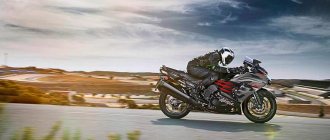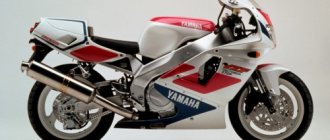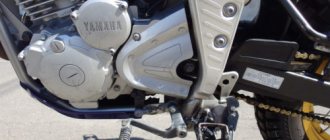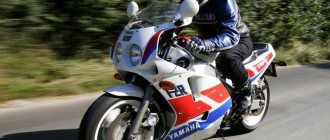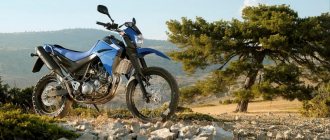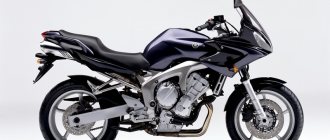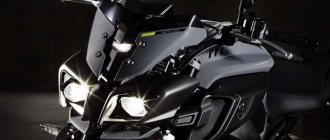Nowadays, the production of motorcycles has increased significantly. The variety of brands is simply colossal. Basically, when choosing any equipment, the question always arises, what is better to buy? In order for the quality to be high, and the price and service to be affordable, you need to pay attention to popular models. They differ in all the necessary qualities that interest buyers. This article will look at the Yamaha company, which has a hundred-year history. It produces quality products. One of the popular models is the Yamaha FZS 1000 motorcycle. It will be discussed further.
Origin of the company
The origin of the company dates back to 1887. It was founded by T. Yamaha. The company was called Nippon Gakki at the time (renamed Yamaha Corporation in 1987). Initially, the Japanese manufacturer produced musical instruments, such as harmoniums, pianos, and harmonicas. In 1889, the production of Western musical instruments was opened.
The company began manufacturing furniture in 1903, applying its skills in wood processing. When World War I began, trade in musical instruments with Japan was closed. But the company was able to take advantage of this, completely covering the domestic market. It produced musical instruments on a large scale and had about 1,000 full-time employees.
The expansion of production and the development of new areas of activity for the company occurred in 1920. Production of propellers for aircraft began. This despite the fact that the company has lost its founder. But thanks to a strong team in the administration, the manufacturer continued to operate.
Yamaha has experienced many ups and downs during its hundred-year history. At the end of World War II, the Japanese government confiscated Nippon Gakki, which produced metal products. But in 1954 the company was returned to the owners. Since that time, the production of motorcycles began. And on July 1, 1955, the line for the production of such vehicles was separated into an independent company, known today as Yamaha. It was controlled by Genichi Kawakami.
The first model of this manufacturer was copied from the DKW RT 125 and was called the Yamaha YA-1 and received the nickname “red dragonfly”. It was after this model that the company became famous. The motorcycle won the first competition in a race at the foot of Mount Fuji.
The production of the Japanese brand began to expand. In 1959, the company launched a line of motor boats made from fiber-reinforced material.
The company expanded quite quickly. In 1964, a motorcycle production plant was built in Thailand, then in 1966 in Taiwan.
Over time, the company began producing snowmobiles and snow removal equipment. The company launched a line for this production in 1968. Yamaha also created robots in 1975 for welding work.
After the Japanese manufacturer mastered the market in the United States, by the end of 1970 it ranked second in the world in motorcycle production. Since the beginning of the 80s, the company competed strongly with the Honda plant. She made attempts to oppress and defeat her competitor.
Since 1982, the company has created partnerships with a French manufacturer to produce scooters.
Development did not stop. Production capacity continued to expand. Since 1985, Yamaha began its operations in India. There are currently two factories operating there. Partnerships were also established with Italian motorcycle manufacturers Minarelli, and since 2002 this company has joined the ranks of Yamaha Motor. In those same years, one of the famous motorcycle models, the Yamaha FZS 1000, was released.
As you can see, the manufacturer has a hundred-year history and limitless experience. Today they produce:
- motorcycles;
- bicycles;
- outboard motors;
- engines for cars;
- all-terrain vehicles;
- golf carts;
- snowmobiles;
- electric generators;
- robots for industry;
- other.
This brand is known and recognized all over the world. The Japanese manufacturer is known for its quality. Therefore, the demand for these products is always high.
History of the motorcycle
By the end of the 90s, it was already possible to draw the obvious conclusion that the concept with powerful engines and miniature fairings was popular. And that the production of “six hundred” and powerful “liter volumes” will enjoy tremendous success among consumers.
Thus, the manufacturers of the Japanese concept went on to produce the Yamaha FZS 1000 model, which launched in 2001. The basis of the motorcycle was a derated engine from its older brother, the famous YZF600 Thundercat model.
The designers decided to install an exhaust system, as well as a power valve from its predecessor. The brake system was also used from an early model. At this point, the donation from this sportbike was completed. In all other respects, this is a completely new concept. The twenty-valve engine was equipped with a new injection system and a special carburetor design. But this contributed to its great mid-range thrust. The designers also tried to improve the lubrication system and transmission.
Currently, a huge number of units of the FZS1000 model have been produced. Most of them are sold by domestic dealers, as well as in Japan, the USA and Europe. In the States, this motorcycle model is called the Yamaha FZ1 Fazer, in Europe - the Yamaha FZS 1000 Fazer. In 2003, this model was even available in South Africa. And in 2006, two modified models with a fairing appeared. The company then improves the rear shock absorber, making it softer, and also improves the fuel injection system.
In 2010-2011, the response to the throttle is modernized, which contributes to improvement in the low and medium speed zone. The final year for motorbike production was 2015. Worthy competing motorcycles for the presented model:
- Honda CBF 1000.
- Kawasaki Z1000.
- Suzuki GSF 1250 Bandit.
However, competitors were unable to force the model out of the market. They are not able to provide such power and controllability as the Japanese popular model. Therefore, she constantly maintained a leading position.
Engine
The revolutionary engine from the Yamaha R1 supersport was throttled by 10 hp. and will be revised in terms of making it cheaper. One of the visible changes is the replacement of the magnesium timing cover with an aluminum one. Some changes have also been made to the lubrication system, which still requires attention - during a test drive it is recommended to heat the engine more and watch the emergency oil pressure lamp. The moment of inertia of the crankshaft was increased to obtain more friendly engine characteristics in city driving conditions. The power system consisted of a battery of 37 mm horizontal Keihin carburetors. The use of these carburetors entailed the reconstruction of the intake system. The changes made made it possible to move it down by 1000 rpm without loss of torque!
Motorcycle Features
Most likely, the main feature of the motorcycle is its engine, which does not create problems on the roads and is unpretentious to the way you ride. The Yamaha FZS 1000 Fazer is perfect for city driving, track racing and off-road use.
For long-term operation, you just need to change the oil in a timely manner and monitor its level. If fuel consumption exceeds half a liter per hundred kilometers, then you should immediately check the cylinder heads. If necessary, the piston rings will need to be replaced. Overall, this sportbike is special. It can evoke indescribable positive emotions while driving.
Motorcycle Yamaha FZ-S 1000 Fazer 2004 review
The description of the Yamaha FZ-S 1000 Fazer 2004 motorcycle is in the queue for publication of the article. Announcement: Today, for almost every new motorcycle that comes into being, marketers strive to carve out their own niche. This one is a road sport, this one is a recreational enduro. But what class should we include a motorcycle that has a little bit of everything? A good bike should have a reliable engine, comfortable ergonomics and simple controls...
Yamaha FZ-S 1000 Fazer is a motorcycle not sold in Russia, equipped with a very powerful 143.1 hp engine. Despite the fact that good models of motorcycles have a very respectable price, and the season for their use is relatively short, the motorcycle market is developing rapidly. And if you believe the words of dealers, then some models of recently released motorcycles are selling like hot cakes at the beginning of the season, and the models brought to Russia are clearly not enough to fully satisfy consumer demand.
A motorcycle has long ceased to be an alternative to a car, and the times when this equipment was bought only because there was not enough money for a full-fledged car are forgotten. Nowadays, two-wheelers can be called technological marvels in many cases, and their cost can be compared with that of prestigious cars.
Many people have started buying motorcycles for hobby purposes as riding or even collecting them has become a good pastime for many people. Many motorcycles, for example the Yamaha FZ-S 1000 Fazer, whose technical characteristics make it possible to call the model a prestigious brand, are in demand among both beginners and experienced motorcyclists.
Currently, it is impossible to purchase a new Yamaha FZ-S 1000 Fazer motorcycle of the 2004 model year, since their production stopped 12 years ago. At the same time, the Yamaha FZ-S 1000 Fazer has excellent technical characteristics, so many people strive to purchase, if not a new, then at least a used version.
Motorcycles with an engine capacity of 998 cc. see, appeared as a result of long work of inventors who sought to create a model that was not inferior in characteristics to other versions of the motorcycle. In some cases, these models are not only not inferior, but also ahead of other motorcycles, as they have minimal fuel consumption and other excellent parameters.
Motorcycles with an engine capacity of more than 400 kb. cm, which includes the Yamaha FZ-S 1000 Fazer - this category of motorcycles simply cannot claim the title of “motorcycle for a beginner.” On the contrary, this is already a serious technique that requires certain control of motorcycle equipment with a smaller engine capacity. Yes, she attracts more attention, she is the most beautiful, fast, interesting and there is a huge selection of models. But as power increases, the weight of the motorcycle inevitably increases. In this class you are unlikely to find motorcycles lighter than 180 kg, unless they are the latest motorcycle models.
Go to the entire range of Yamaha motorcycles, on this page you can find Yamaha FZ-S 1000 Fazer motorcycles from other years of production and information about them
Specifications
The model name FZS1000 Fazer existed from 2001 to 2005. Then it was changed to such markings as FZ1-N, FZ1-S Fazer. The type of motorcycle itself is “naked”. The duplex frame is made of chrome-molybdenum steel and has a completely original structure and great strength.
The technical characteristics of the Yamaha FZS 1000 Fazer make it clear that this machine is simply a beast. It has a four-cylinder, four-stroke engine with a displacement of 998 cm³. The diameter of the cylinder piston until 2005 was 74x58 mm, and then it became 77x53.6 mm.
A linear liquid cooling unit completes the system. Has five valves per cylinder. Initially, the fuel supply system was carburetor, then it was improved to an injection system, equipped with a throttle position sensor. Type of fuel - gasoline. The ignition type is digital transit. The maximum power of models before 2005 was 143 hp. With. at 10,000 rpm. Then the vehicle was improved. The figures began to reach 150 liters. With. at 11000 rpm.
The gearbox has six stages, which contributes to smooth gear shifting. Drive type: chain. The front brakes have two 298 mm discs. The rear brake consists of a single 267 mm disc. The motorcycle designers equipped the unit with energy-intensive suspensions. There is a telescopic fork installed at the front, and a pendulum fork at the rear with a monoshock absorber, which can be adjusted by preloading the spring.
It is also worth noting that thanks to weight distribution, massive standards and chassis adjustment, the unit has acquired excellent stability and good handling. The maximum speed of the motorbike is 260 kilometers per hour. It accelerates to one hundred kilometers in 2.9 seconds. The weight of the unit is 208 kilograms. When equipped, this figure reaches 231 kilograms.
The test drive was scheduled for 9.30, just at the end of the morning rush hour. The testing area is the center where the nearby streets near the motorcycle dealership form a rectangle that includes four busy intersections and one busy straight line. And where to check the streets if not on the streets of the city! At the appointed hour, the subjects appeared in all their glory, reflecting the rays of the morning sun with their varnished tanks... Long preparations, conversations, and then the engines shuddered, dousing the surroundings with a bass rumble. These are not toys, but liter “planes”. Moreover, despite their external similarity, already in the first seconds you can draw a clear line between them by listening to the engines: Fazer is an attack fighter, ready to shoot from the sidewalk deck onto the street, frightening motorists with the howl of an inline four, and SV is a low-speed attack aircraft, but not less dangerous: a more aggressive landing and the specific rumble of the V-twin excites some kind of creepy feeling in the lower abdomen...
Yamaha FZS1000 Fazer 2001, 998 cm3, 143 hp, mileage 7200 km, $8000 Debuted in September 2000, this street fighter received a derated power unit from the R1 and an exhaust system equipped with an EXUP power valve. The brakes were carried over from the sportbike without changes, and the prudent “samurai” decided to save on everything else. The duplex frame is welded from steel pipes, the simple box-section rear suspension swingarm is made from aluminum alloy. The suspensions are adjustable based on spring preload and hydraulic characteristics. Despite the apparent budget and simplicity at first glance, this bike immediately occupied its niche in the market. Maintaining this leadership, Fazer has no real competitors to this day, but this test drive may tell you what this is connected with... Semi-fairing with headlights slanted like the eyes of an Asian girl, high steering wheel, direct landing, comfortable seat and footrests , located almost close to the ground. All this is aimed at maximum comfort and relaxation, but I clearly understood that such global relaxation will not get along with 143 forces even before I drove the first lap...
When driving sports in a city crowd, there is always a lack of traction at medium and low speeds. Looking ahead, I want to say that the traction at the bottom is still “not very good”. I don’t know what the Yamaha engineers were guided by when they “choked” the engine. But they failed to remove the aggressiveness of the sport from the liter Fazer. Or maybe they didn’t want to do this? Judge for yourself... The short throttle remains the same - the first sign of sports aggression. “Strangling” at 6 horsepower is simply ridiculous. The liter Fazer has 143 “horses” at the crankshaft, like a good sports bike. The carburetor settings have hardly changed. The schedule was smoothed out a little and that’s it. Moreover, this is “a little”, probably just due to those six horses, the absence of which is almost not felt. Especially if you change from R1. In general, his character is evil, like his engine. So you don’t have to forget about the brakes... A front fork that bites during heavy braking and a stubborn reluctance to turn does not at all add confidence in piloting. It's probably all about the weight distribution. The fact is that the Fazer has a very high center of gravity. It starts to “break” a little at low speeds, when changing lanes between cars. In my opinion, driving in the “a la classic” style is not for him. Its element is gripping, because after passing through the mid-speed zone the engine behaves very defiantly. Driving at low speeds is, on the contrary, torture. The chassis — I’ll say this: a bit soft for an aggressive driving style. The swingarm, of course, does not fidget on the highway, but the front fork is frankly weak and requires tuning springs and more viscous oil. You can’t go into turns “with your knees” anymore: the rear wheel moves. The rear shock absorber may need to be adjusted, or maybe replaced. From the very first minutes of communication, I realized that it would be very difficult for us to become friends. But there is nothing to find fault with, this is not an R1, but a Fazer... The roller-coaster motorcycle shoots quite briskly on straight lines, demonstrating excellent traction already from 5 thousand. I appreciated both the distance from the seat to the driver’s footrests and the wind protection, although the flow of oncoming air begins to annoy me already from 150 km/h. When you look in the rearview mirrors, it seems like a super sport is going on. By the way, the mirror arms on the FZS1000 are located so well that you don’t have to scoot the motorcycle to the sides when squeezing between the cars. Rear view mirrors are located higher than many domestic and foreign cars. For example, on my first motorcycle in the first season I knocked down four mirrors. It was a pity for the “chisel” and “ten” drivers, but for some reason in traffic jams they constantly put their “ears” at the level of my mirrors! Moving in traffic on a Yamaha is quite convenient: the high seating position allows you to track all the “staggering” of motorists along the lanes. Despite the rather long wheelbase, the speed and engine speed are quite suitable for lifting the rear wheel from second gear: both from 40 km/h and from 120 km/h. This is what the bike immediately demonstrates, showing its tough temper. Fazer's brakes are good for sports and work with a huge reserve: even the rear brake, which is usually just a useful add-on on such bikes, is quite informative. Several times, while performing a stoppy, instead of the expected rise on the front wheel, I got it completely locked: after all, the fork takeoff angle and base here are sportbike ones! The clutch handle somehow sticks out far forward in an unchildish way. The first desire is to adjust the clutch lever to suit you. Fuck you! Is there really no wheel with the coveted numbers 1-2-3-4-5? Damn it, no! The inability to adjust the main controls is another manifestation of budget constraints. Okay, we'll survive. Whoever doesn’t like it, let the “maguru” put it... The engine’s operation clearly shows its sporting roots: the throttle is very sensitive and torque is easily transmitted to the wheel, while the engine makes the sounds of a jet coffee grinder, warning everyone of its approach. Cars shy away as soon as they see an evil face in the mirrors... I was very pleasantly surprised by the performance of the gearbox, which is usually the Achilles heel of the company's products. The classic dashboard hides the aggressive mood of the motorcycle well, everything is in its place, it is easy to read and understand - nothing superfluous, everything is recognizable and does not distract. Ancient (by today's standards) carburetors are quite adequate in their work, but they add aggression to the motorcycle and therefore I would not recommend the bike to beginners, but for experienced city shooters it is quite suitable for every day, even despite its versatility. Having parked at a motorcycle dealership, I exchange the Fazer for another bike, giving other pilots the opportunity to test it. After Yamaha, the expression in the eyes of the SV reminds me of the fox face of a slightly sad silver fox...
+ relatively low fuel consumption + large gas tank volume + elastic engine + comfortable passenger seating + comfortable ergonomics - average handling - low-mounted driver's footrests - heavy weight - overly soft suspension tuning = powerful motorcycle for straight roads
Suzuki SV1000S 2005, 996 cm3, 124 hp, mileage 15,200 km, $8,900 The success of the SV650 prompted the company to introduce in September 2002 a version equipped with a modified V-twin engine from the famous Suzuki TL1000R superbike, with a 90-degree camber cylinders, with an injector and liquid cooling, which was previously derated to 124 hp. The motorcycle has an original aluminum frame, cast in a vacuum under pressure, and an aluminum rear swingarm. The suspension is fully adjustable not only for spring preload, but also for hydraulic compression and rebound resistance. Starting the engine of this motorcycle wakes up the beast and the vibrations running through its steel body make the heart beat faster. The bassy, low-pitched sound of the V-twin spills out from the mufflers around the area: here it is, that sound in which one can feel the undisguised and calm power that stands against the howls of the opponent.
Japanese companies have learned to make their cars not only reliable and technically correct, but also beautiful. Isn't the SV1000S like that? Admire how the faceted half-fairing blends with the raked front fender and seat, frame grille and fuel tank bulges. If earlier the Japanese certainly imitated the European style, now, without hesitation, they flaunt their creation - huge headlights eliminate all doubts about the origin of the device. What do you think of the lines of the lower fairing and exhaust pipes? Simply sportbike class! However, real delight will be caused by a more detailed examination of the Suzuki SV1000S. The “clip-ons” steering wheel (not one-piece, like a competitor’s, but made of two halves screwed directly to the fork tubes) and a chic high-tech instrument panel, which combines a digital speedometer and an analog tachometer, fully correspond to the style. The latter attracts attention with its size and white and red backing. They say, unscrew me to the fullest! The seating position, it must be said, is a real streetfighter's one - with a sports saddle-step, a noticeable forward tilt and load on the hands. This is the result of a low handlebar position and rear-mounted footpegs. This geometry allows you to sit comfortably on the tank, which means you can feel comfortable behind the windshield at speeds of “over 200 km/h.” But while weaving through traffic, I didn't find any benefit from the leanness that comes with the narrower twin-cylinder engine. But due to the lower landing on the Suzuki, its pilot in traffic jams is in a noticeably less advantageous position than the owner of the Yamaha. There are also vibrations, although they are quite moderate and do not cause a feeling of any displeasure or discomfort - only if you immediately switch to a motorcycle after a four-cylinder in-line engine. However, I would not exaggerate and say that they somehow interfere with life: after half an hour of driving you completely forget about them. As soon as such an opportunity arose, I immediately drove the tachometer needle closer to the red zone, watching the flickering of three-digit numbers on the digital speedometer. Accelerating relatively briskly at first, the bike reacts asthmatically to movements of the right hand in the “over 10 thousand” rpm zone. Oops, that's the end of the straight... Due to the lower center of gravity, maneuvering is very easy and in turns it seems that the car is on autopilot. No splitting of the rear pendulum or twisting of the “body” on uneven surfaces. Tumbler, and that’s all! And everything is the merit of the V-shaped engine, only with it such a concentration of masses and the lowest possible location of the engine crankcase is possible. The result: a record low seat height - just 810 mm, just like a sports car! True, the overly rigid standard suspension setting (this, of course, can be corrected) and the embryonic landing make you periodically think about rest. However, this is not a drawback, but rather a hint at the real purpose of the bike. Of course, it’s impossible to say that the SV1000 has sportbike-like control precision, but the overall perception is noticeably improved. Thanks to the SDTV (Suzuki Dual Throttle Valve) injection system with two dampers in the air path in front of the nozzles, the injector “breathes” deeply. A 9-liter air filter casing is located above the frame, tuned to resonance, and even traction from the very bottom has not disappeared anywhere, but in slow turns at right angles (by and large, the city consists of them), this indicator much more important than the absolute value of power. When exiting a corner, you can accelerate much more energetically, and when braking, the help of the V-twin is clearly felt, because even with slightly higher compression than the Yamaha, there are only two cylinders. And instead of the hysterical howl of an in-line “four” in such cases, you hear the pleasant low-frequency rumble of a large twin. Only during such exercises should we not forget that the flip side of such effective engine braking can be a sharp locking of the rear wheel, although this drawback is “cured” by installing a slipper clutch. It would seem that the long wheelbase will stop any reckless driver from testing this “hooligan” cruiser to its fullest. But aerobatics is so surprisingly easy that at first it is somewhat disorganizing. The “Liter” steers with the precision of six hundred, but as soon as you open the valves a little more sharply, the rapid pickup (in the first three gears the bike easily lifts the front wheel) reminds you of the cubic capacity and the considerable number of horses in the engine. From fast pulls to center-mounted climbs, the bike can move from point to point and accelerate at your command, it will always do it. However, there is a slight tendency in handling that feels underpowered when cornering at medium speeds. This results in the turning line being averaged out over poorly surfaced surfaces, instinctively reducing the danger of lowside to a minimum. Gear shifting, as expected from Suzuki, does not cause any complaints: everything is as clear as a clock. The situation with stoppy is very similar to that of the opponent, that is, there are all the possibilities for such a maneuver, but more skill and concentration are required. I begin to look around, get used to the new vision of the world in the rearview mirrors. After Fazer, of course, “not a fountain.” Several attempts to adjust the view led to the fact that approximately 70% of the surface of the mirrors became a clearly visible area. But 30% is still my elbows. No matter how hard I tried, I couldn’t find any problem with the brakes, where a nice feature was the good information content of the rear caliper. As for the operation of the front calipers, in real life they are definitely sufficient; Only when operating on some really high-speed track, where repeated braking on the verge of a foul, say from 250 km/h, is a working moment, they may not be enough. But this will no longer be the area of application of this device. Let me note a funny incident during the test: the same amount of fuel was poured into the motorcycles, but at the end of the test drive the Yamaha’s fuel light only came on, but the Suzuki did not complete the last lap, demonstrating its gluttony, despite the injection and less powerful compared to the carburetor Fazer's engine... It is pleasant to state, summing up the riding impressions, that the designers equally managed to endow the SV with the advantages of both sportbikes and neoclassics, while almost eliminating the disadvantages of both. A loyal attitude towards the pilot and a willingness to forgive a lot, despite its aggressive appearance and large volume, puts this “liter” in a more advantageous position than the uncompromising Fazer, despite a whole bunch of advantages. Still, for me, in the primitive unscrewing of the throttle there is much less adrenaline and pleasure from piloting than from quickly passing a winding trajectory. But you can install “direct flow” on the Suzuki, and then the difference in weight with the Yamaha will become completely indecent for the latter...
+ excellent handling + “breaking” traction at the bottom + design that has not lost its relevance + good wind protection - small gas tank - ergonomics uncomfortable for tall pilots - high fuel consumption - standard mufflers leveling out the “correct” sound = a motorcycle with character
Opinion: Valera DRIVE Height: 186 cm. Weight: 112 kg. Why are most people in our country maximalists? If it’s a car, then it’s a Porsche Cayenne Turbo, and if it’s a motorcycle, then it’s definitely a liter one? From my point of view, all this is superficial, a show-off for visitors. After all, to cope with the irrepressible energy of both the first and the second, EXPERIENCE is needed, not to mention money... Both tested are not sportbikes, although they can easily “tear” the aforementioned car monster like Tuzik a heating pad, without particularly straining, but again, under controlled by an experienced rider, otherwise the motorcycle may tear you apart... And so, if you look at the Yamaha FZS1000 and Suzuki SV1000 from this point of view, that is, the position of a not very experienced pilot, then my preference will be on the side of the Fazer. Although it is more powerful than the SV and also knows how to “fly” on the rear wheel, it still does this only after 8 thousand revolutions. But Suzuki is ready to “hooligan” almost from idle and in the first three gears, without really asking your permission. Yes, it steers much better and “shoots” faster from a standstill, BUT! Active safety is at the forefront of safe driving, as such, and what an experienced person enjoys, scares an inexperienced person (until he learns). And here the Fazer, with its softer reactions, clearly gives the SV a head start...
Opinion: Valery Kalinchuk Height: 178 cm. Weight: 87 kg. It's always nice to compare powerful motorcycles. These are the flagships of the line, in which the creators always put a twist. After all, this is the face of the company. Today we have our sights on the Suzuki SV 1000 and its classmate Yamaha FZS 1000 Fazer. Let's start with the appearance. Despite the fact that the Yamaha provided was four years older than the opponent, its design could not be called outdated. High tank, original round rear dimensions, modern front fairing with two headlights. Few motorcycles from the new model range can boast such completeness of form. The analog gauges look a little dated, but some will find this an advantage. Suzuki, standing nearby, may even be confused with an opponent at first. But upon closer inspection, it is noticeable how different they are. The first thing that catches your eye is the one exposed engine cylinder. The second is hidden from view in the depths of the frame. A beautiful rear tail, almost like a sport bike, with original size bars, makes it stand out from the crowd, but as for the two mufflers, they look somewhat cumbersome and unfinished. The designers, in my opinion, left this element to chance. They do not harmonize with the motorcycle, neither in height nor in width. So, they attached two cans to the side, and let them hang there. But the information panel is made “perfectly”. Convenient analog tachometer and digital speedometer. Everything is before your eyes and is perfectly readable. After the external inspection, it’s worth moving on to road tests. And then it became clear how different these two motorcycles are. When driving, they are not similar to each other either in the nature of their engines or in their handling. The SV was the first to start. I must say that the rumble of the engine is very pleasant. Somewhat reminiscent of a helicopter. The motor is configured to work from the bottom. That is, the pickup starts already from 1500 rpm, and this is not even a pickup, but a hurricane. The motorcycle simply jumps forward like a zealous horse, standing on its rear wheel. But he has no tops. No matter how strange it may seem, after 7000 rpm the motorcycle withers, and you have to switch to a higher gear earlier. But for the city, this character is more of an advantage than a disadvantage. You can always ride calmly without keeping the tachometer needle in the high rpm zone, knowing that when you open the throttle the motorcycle will jump forward and not sluggishly accelerate. Another advantage of the V-twin engine is its excellent weight distribution. The motorcycle handles great. Equipped from the factory with a steering damper, it is perfectly predictable when turning and does not stall. It's nice to lean the bike into a corner without feeling the weight of the front end dragging the bike down. Great settings! Now let's try to ride the Yamaha. Here the picture is exactly the opposite. Fazer boasts a sporty engine from the R1. And even if he is a little deformed, the heredity is obvious. The in-line, sports engine makes a characteristic sound, especially at the top. In dynamics, it is also close to its ring counterparts. Good dynamics up to 7000, and a new pickup after. Yes, so strong and smooth that in first and second gears you can calmly, without any extra effort, put the motorcycle on the rear wheel. The situation with taxiing is different. Due to the heavy front end, the motorcycle wants to go into a stall when cornering. Even the damper that was equipped with the device provided for testing does not help. You have to constantly monitor the turn. The braking of both opponents is at the same level, there are no complaints. Due to the weight distribution, the front end of the Fazer settles a little more on the shock absorbers, but this does not affect the final result. The rear wheel locks perfectly and is controlled when sliding. After the test, I thought about which of these motorcycles I would choose for myself. And I couldn’t answer. Probably Fazer (for acceleration) and SV (for cornering). They are so different that it is difficult to make a choice, but this can be done by assessing your needs and experience.
Text: Ivan Borsch (height 178 cm, weight 80 kg). Photo: michel
Dimensions
When purchasing, you should pay special attention to the size of the bike. Driver comfort depends on this. The overall dimensions of the unit are impressive:
- length – 212.5 cm;
- width – 76.5 cm;
- height – 119 cm;
- saddle height – 82 cm;
- wheelbase – 145 cm;
- front tire – 120/70;
- rear tire – 180/55.
The bike is suitable for people of average and tall height. Body weight may be large. At the same time, the motorcycle maintains good handling.
Fuel consumption and tank capacity
The fuel consumption of the Yamaha FZS 1000 is, according to official data, 6.5 liters per hundred kilometers. But it should not be ruled out that gasoline consumption also depends on driving style, so the figures may fluctuate.
The gas tank capacity of this model is 21 liters, including a reserve of up to four liters. This allows you to travel long distances without refueling.
Advantages and disadvantages
Based on the characteristics of the Yamaha FZS 1000, we can safely note the following advantages:
- maneuverability is excellent both at speed and in traffic jams;
- power is easily controlled;
- The braking system is excellent;
- There are no problems with consumables, everything can be found on sale;
- sufficient choice for tuning Yamaha FZS 1000;
- reliability and quality;
- comfortable fit for city and long trips;
- good weight distribution;
- panoramic view of mirrors at 5;
- Without much effort, the dashboard is easily customizable.
The disadvantages include the following facts:
- after factory assembly, it is worth checking all the tightening nuts;
- the tank is only 17 liters, if you do not take into account the reserve four liters (a larger volume could be installed);
- high tax (about 7,500 rubles per year).
The model's shortcomings cannot overshadow its advantages. That's why the bike is still popular today.
Yamaha FZ1 (FZS 1000) motorcycle review
I have owned a Phaser since May 2009. Bought new with ABS. Now the mileage is 12,000 km. Additionally, I installed arches with sliders.
I was choosing between the classics Honda CBF 1000 and Yamaha FZ1-S. I bought it for traveling around the city, to and from work. I can’t afford something smaller, because I weigh 120 kg and height 192 cm. I couldn’t imagine a chopper around the city in the aisles. The sport-tourist is heavy and not the best option for the city. At first I was leaning towards the CBF 1000, but after studying the characteristics the choice fell on the FZ1-S.
Aluminum frame, 150 hp power, inverted fork, more aggressive design and little things. At the same cost when equipped with ABS.
Comfortable seating position for city trips. The tank is 18 liters, enough for 200-250 km in the city. With the low fuel indicator blinking, you can drive at least another 15 km. The odometer countdown in kilometers begins.
Speedometer and odometer (two odometers) are electronic. Pointer tachometer with cut-off at 12 thousand revolutions. The cutoff is triggered by dropping the speed somewhere to 11 thousand revolutions. The panel displays fuel level, engine temperature, air filter temperature, clock, direction indicators, neutral, ABS, high beam. There are additional adjustments in the submenu.
A fairly smooth increase in speed up to 5-6 thousand revolutions. After 6 thousand revolutions, the acceleration dynamics increase significantly and 150 hp are already felt. During operation, there was a lack of dynamics from the very start to 5 thousand revolutions, I decided to change the drive sprocket to 16 teeth (standard drive 17, driven 45) to increase dynamics, but of course, lose maximum speed. The engine is quite noisy, there is a lot of extraneous noise.
The box works clearly, but with little effort.
The brakes are powerful enough, quite enough for aggressive driving. ABS works in the most extreme cases and intervenes on the verge of blocking, while working on the principle of an automobile. ABS is not combined, separate front and separate rear. Reinforced hoses.
The suspension works well, there were no breakdowns, but I still decided to tighten it up in the coming season, make it stiffer, I’m just getting used to it. The suspension front and rear is fully adjustable. You can pinch it if you want.
In addition to the side step, there is also a central one, which is convenient for cleaning and lubricating the chain.
The wind protection works well up to 180 km/h, then I just lie down on the tank. If desired, you can install the glass higher.
You can fold the mirrors by hand if you can’t squeeze through somewhere. The mirrors do not shake when moving.
The muffler really muffles the sound, so it was installed in direct flow to at least somehow be noticeable to other road users.
Both headlights work for low and high beam. H4 lamps. They turn on automatically when the engine starts. There is enough lighting.
It comes with a Yuasa gel battery, which lasted me for a season. During storage, it should not be allowed to discharge below 7-9 volts, because then it will not take on more than these values. I changed it, the battery is expensive.
The standard Danlop tires are quite hard, but they were enough for 11,000 km. True, lately I have often driven with number two, the tires could have lasted longer that way. Front cylinder 120/70, R17, rear 190/50, R17.
The tax when accounting in Moscow turns out to be quite high - 7,500 rubles.
A universal motorcycle for the city and the highway.
Previous riding experience - operating motorcycles from the highway to the mountains (2400 m.) Java and Vulcan - highway-city. At the end of this season I took the Phaser, rode 3.5 t.km.
3 days after the purchase, I tightened the front fork, because... The factory setting is no good (a couple of times, when braking, I almost fell off the steering wheel). The previous owner installed reinforced brake hoses, a damper, sliders and a radiator lining. Because I bought it through a dealership and they changed the tires there.
The brakes, derivatives from the R-1, work perfectly. By replacing them with reinforced ones, they allow fine adjustment of the braking force. I brake the front with two fingers, but there’s a problem with the rear! I blocked the rear wheel several times and have not yet been able to find the optimal force.
Sliders - once at an intersection, while changing lanes, I managed to roll it over on its side. After inspection I didn’t find anything! smile.gif
Damper - thanks to our roads, I realized that this is the most important thing for a motorcycle capable of walking over 180 km. On the 200s, driving with my wife, I let go of my hands - as if on rails!
My height is 177cm, my seat height is 820mm. A little high for me. The semi-fairing does its job well, no complaints on my part. The rear-view mirrors are located in such a way that if you walk between cars, then there will be no problems with the rest. They do not shake at speeds and provide a good overview.
Handling depends on the tires. I have a new Bridgestone BT 020, which belongs to the sports-touring class. I can’t say anything bad: in the rain I easily drove away from the 900 cc Ninja.
For 3.5 t.km. added 300 gr. oil, they say that this is the norm for Yamaha. The gearbox could work more smoothly, especially when switching to a lower gear.
General — Neither in the city nor on the highway has I ever been overtaken by a barn on 4 wheels. The acceleration dynamics are such that it easily holds its own in the first 3 gears. Once he shot from a traffic light so hard that he flew for 500 meters in the back. (I almost pooped myself out of fear. laugh.gif)
Overall, I’m very pleased with the device. After all, it combines both street and sports.
Advantages:
1. Power and speed are easily controlled at any speed
2. Steers perfectly both at speed and in traffic jams
3. The brakes are excellent, and after installing reinforced hoses they are great
4. Reliable
5. There are no problems with consumables and tires
6. Large selection of tuning
7. Doesn't overheat
8. Comfortable seating for the city and long-distance driving
9. Excellent weight distribution for turning on the running board
10. Central stand (you can easily lubricate the chain alone and remove the rear wheel)
11. Comfortable passenger seat
12. Even the standard light works great. and both low and high in both headlights
13. Review in mirrors 5+
14. Easy to read and customizable dashboard
15. Sound... (Yosha rules)
Flaws:
1. The mirrors become loose right at the factory (although, strangely enough, this does not affect the image)
2. The tax is high (RUB 7,500/year)
3. The chain and sprockets are “consumables”, enough for a little more than 10 thousand.
4. The tank is only 17 liters. consumption in the city is 7-8l, on the highway 5-6l (autonomy approximately 260-280km)
Bottom line: a universal bike for the city, long-distance driving, cross-country and gripping, shorter than all possible road rides. Now we had to part, but I’m sure it won’t be forever, we’ll ride again)))
Spare parts and repairs
When purchasing any type of transport, the main question for the consumer is always whether its maintenance and repair will be difficult.
The Yamaha FZS 1000 model is quite common, which ensures the availability of any spare parts and components on the motorcycle markets. It is also worth noting that the company is quite well known; in almost all major cities there are dealerships that can help you get any part at the factory price. It will not be difficult to find the necessary components in online stores. Moreover, they feature many trading platforms that supply both used materials and new spare parts.
Price
Based on the technical characteristics of the Yamaha FZS 1000, it is worth noting that the pricing policy is acceptable for such motorcycle performance. The cost of a bike without mileage, according to official data, is:
- for first generation motorcycles (FZS1000) – 215-230 thousand rubles;
- second generation (FZ1-S, FZ1 Fazer) – 400-450 thousand rubles;
- modernized second generation (FZ1-N, FZ-1) – 350-400 thousand rubles.
As for used motorbikes, the price can range from 110 thousand rubles. for the first generation, and for the second - from 200 thousand rubles. But it is also worth considering that the cost is formed in accordance with the year of manufacture of the unit, its appearance and technical condition.
Frame and body kit
The frame is quite simple - two-tube made of chrome-molybdenum steel. Relatively advanced users consider its rigidity insufficient for the power capabilities of the motorcycle, but for everyday and touring use it is quite enough. In order to further reduce the cost of the motorcycle, the titanium muffler was replaced with a stainless steel unit. The radiator has also been reduced in size. However, it still protrudes quite noticeably beyond the dimensions of the motorcycle. To reduce the likelihood of damage to its side cans, they were covered with steel linings. Changes in the engine power supply system made it possible to install a tank of quite impressive volume. The headlights from the R1 are integrated into the half-fairing. The instrument panel is easy to read and is equipped with an almost complete set of indicators and indicators that a tourist may need.
Reviews
The owners give positive reviews about the Yamaha FZS 1000. And they especially note that the model deservedly gained its popularity. A motorcycle is an excellent transport both for moving around the city and for long trips.
Users are satisfied with this vehicle. They choose this model for its build quality, minimal braking distance and instant acceleration. And buyers also claim that they have never been overtaken by four-wheelers. The acceleration power dynamics make it easy to get on the flails in first gear.
